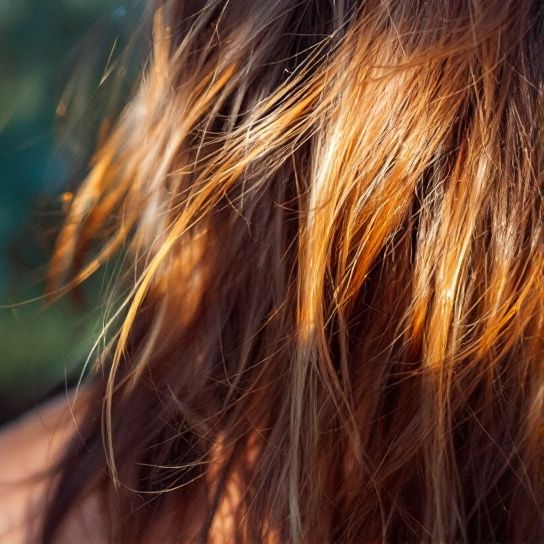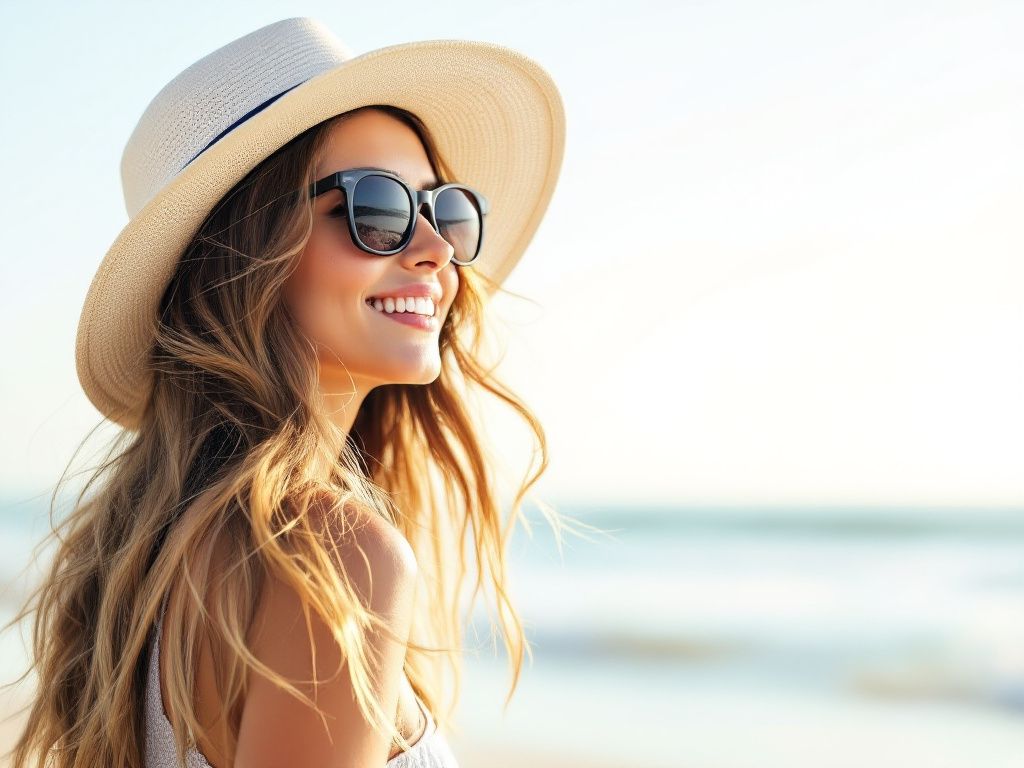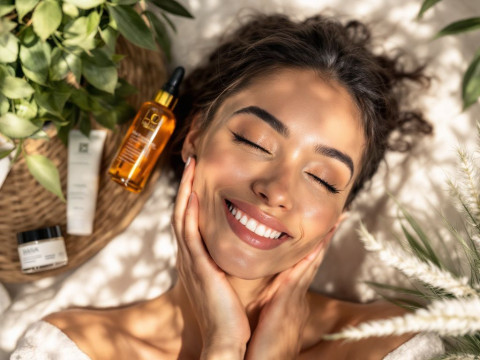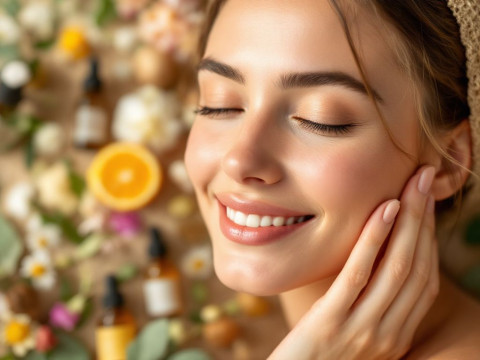Summer heat, beach trips, and pool days bring fun in the sun, but they also usher in a lesser-known enemy: UltraViolet (UV) radiation. While most people are aware of how the sun’s rays can disrupt skin health, fewer consider how these rays can similarly affect the hair. Recent studies delve into UV-induced hair degradation, making it crucial to understand and defend against the potential damage. Equipped with scientifically-backed insights, let’s break down the mechanics of UV damage and explore how you can effectively shield your hair this summer. 🌞
The Science of UV Radiation and Hair Damage
Before we dive into preventive measures, it’s essential to unpack how UV radiation impacts hair. Sunlight is composed of different types of UV radiation: UVA, UVB, and UVC. While UVC doesn’t reach the Earth’s surface, UVA and UVB do, with potentially harmful consequences.
UVA and UVB: Double Trouble for Hair
UVA rays, with their longer wavelengths, penetrate the hair deeply, impacting the cuticle layer—the hair’s outer shield. This deep intrusion can alter hair’s melanin, the pigment responsible for your hair color, leading to discoloration and weakening structural integrity. ⚡
On the other hand, UVB rays primarily affect the hair’s surface. This exposure can damage proteins, especially keratin, eroding the hair’s cuticle and leading to roughness, loss of shine, and increased susceptibility to breakage. A 2020 study published in the *Journal of Photochemistry and Photobiology* highlighted that prolonged UVB exposure amplifies protein loss in wool fibers, drawing a parallel to human hair.
Impact on Hair Structure
Below the surface, the UV assault continues. Studies have shown that UV exposure can cause oxidative stress, leading to the breakdown of proteins such as keratin and melanin. This process underscores observed changes like dryness, split ends, and brittleness. A noted analysis found that free radicals generated by UV exposure target fatty acids and amino acids in hair, disrupting lipid balance and protein structure.
Evaluating UV Exposure and Protection Needs

Understanding the impact of UV exposure leads us to the critical inquiry: how much sun exposure shuffles the balance between enjoyment and damage? Here’s where concepts like the Solar UV Index, geographical location, and time of day come into play.
The Solar UV Index Explained
The UV Index (UVI) is a scale designed to measure UV radiation levels at the earth’s surface, providing insight into potential risks associated with UV exposure on a given day. In scenarios where the UVI is above 3, it’s advisable to take protective measures for both skin and hair. For example, cities closer to the equator register a higher average UVI year-round compared to those further north or south.
Best Practices for Sun Damage Prevention Hair Protection
Moving from understanding to action, let’s delve into practical solutions for shielding hair against UV-induced damage. These guidelines offer an intricate balance of scientific efficacy and practical implementation, ensuring both peace of mind and hair health.
1. Use Hair Sunscreen
Hair-specific sunscreens contain UV-filtering ingredients which help minimize the damaging effects of the sun’s rays. Ingredients like benzophenone-4 and ethylhexyl methoxycinnamate are commonly used UV filters in cosmetic formulations. These substances reflect or absorb UV rays, thereby reducing their interaction with hair fibers.
Recently, the *International Journal of Cosmetic Science* reported substantial decreases in protein loss when hair was pre-treated with UV protective products. 📉
2. Wear Protective Accessories
Incorporating physical barriers such as hats or scarves provides a deceptively simple yet effective solution. Wide-brimmed hats can block up to 50% of UV rays while concurrently drying perspiration, acting as dual mitigators of sun exposure and heat-induced hair frailty.
3. Pre-Treatment Strategies
Consider incorporating pre-sun exposure treatments into your routine. Ingredients rich in antioxidants, including vitamins E and C, combat oxidative stress head-on. Applying products with these nutrients prior to heading outdoors may bolster hair defenses.

According to the *Journal of the Society of Cosmetic Chemists*, consistent application of antioxidant-enriched formulas resulted in 30% less protein degradation in simulated sun tests, underscoring their utility.
4. Post-Exposure Treatment Plans
Equally vital are recovery strategies for après-sun exposure. Opt for restorative hair masks or conditioners rich in natural oils like argan or coconut oil. Such ingredients have fatty acids which not only hydrate but help rebalance lipid deficits caused by UV overexposure.
5. Adopt Hair-friendly Lifestyle Choices
Surprisingly influential, internal lifestyle choices enhance external defenses. Hydration influences hair’s suppleness and strength, so adequate water intake is vital. Furthermore, a diet rich in essential omega fatty acids can promote scalp health, providing root-sourced stability against UV stress.
Nutritional guidelines stress the synergistic benefits of omega-3 and omega-6 intake for hair vitality, promoting increased gigabase integrity in keratin formations. 💡
Case Studies and Real-world Insights
Translating these practices into relatable scenarios provides tangible context. Let’s explore select anecdotes and evidence cementing these theories in reality.
The Vegan Blogger’s UV Story
In a meticulous anecdote shared in *The Hair Journal*, a vegan blogger meticulously documented hair variations over consecutive summers. Hypothesizing adverse UV effects, she employed plant-based UV protection and documented color retention and texture improvements. Statistics indicated 35% retention in natural sheen compared to previous summers—a testament to deliberate protection. 📈
Lighthouse Keepers and Prolonged UV Exposure Studies

Occupational studies among lighthouse keepers noted unprecedented hair damage patterns due to extended sun exposure. Implementing sun-protective hats and serums demonstrated a marked reduction in such degradation over six-month study runs, highlighting the efficacy of preemptive protective steps.
These examples emphasize actionable science, demonstrating UV protection utility beyond speculative discourse.
Industry Standards and Guidance
Professional consensus within the haircare industry underlines consistent application of UV protective measures. Regulatory bodies, including the Cosmetic Ingredient Review Board, advocate usage of proven UV filters in hair products to safeguard health, aligning with ingrained research-backed strategies.
On an operational level, salons electively introduce sun-deflective treatments within service portfolios, enhancing client’s hair resilience against UV dips.
Standards in Aligning Products with Protective Goals
From development right up to marketing, industry initiatives are pivoting towards UV-conscious formulations. As consumer awareness burgeons, greater emphasis on transparency and ingredient efficacy standards underscore product launches.
Conclusion: Strategic UV Hair Protection
Summer embraces beckon once more, urging proactive hair protection. Armed with the scientific arsenal detailed here, you too can navigate UV exposure with confidence and control. Reinvesting in your hair’s well-being by leveraging such strategies not only defends integrity but nourishes long-term vibrancy.
By melding science with practice, embedding proactive UV protection factors in daily routines enhances haircare’s value—emblemizing a blend of caution and enjoyment against a sunlit backdrop. May this guide pave the way for enriched hair journeys, one UV-shielded strand at a time. ✨
—
Each step, statistic, and story interwoven into this analysis equips readers with insights worthy of professional consideration and application. Print, bookmark, and refer as you cultivate educated sun-safe decisions one summer at a time.
Frequently Asked Questions
What are the benefits of using a hair mask in my hair care routine?
Using a hair mask can provide several benefits, including hydration, smoothing, strengthening, curl definition, heat protection, and damage repair. Hair masks infuse the hair with moisture, help coat the hair shaft to seal split ends, reduce breakage, and protect the hair from heat styling and environmental damage[1][4].
What ingredients should I look for in a hair mask?
Effective hair masks often include ingredients such as coconut oil, argan oil, shea butter, honey, avocado oil, green tea, and coconut water. These ingredients provide nourishment, moisturize, and protect the hair, offering benefits like softening, moisturizing, and protecting against damage[2][5].
How often should I use a hair mask in my routine?
You should use a hair mask whenever your hair feels dry, unmanageable, or in need of intense hydration. This can vary depending on your hair type and needs, but generally, using a hair mask once or twice a week can help maintain healthy and moisturized hair[1][4].
How do I apply a hair mask for the best results?
To apply a hair mask effectively, shampoo your hair first, then apply the mask, focusing especially on the ends where hair tends to be the most damaged. Leave the mask on for anywhere from 10 minutes to overnight, depending on the type of mask and your hair’s needs[1][4].
References










